SAMPLE NATIONAL POLICY AND PLAN
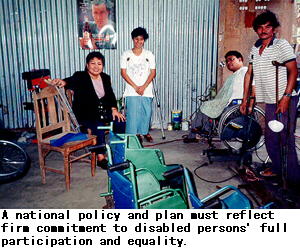
A. Policy commitment
A national policy and plan for assistive devices should be based on firm commitment to the full participation and equality of people with disabilities in society. That commitment, to be expressed by the highest executive of a Government, should stipulate the goal of the state to enable people with disabilities to participate, as full citizens, in the economic and social life of society, and the duty of the state to ensure their participation. Government policy statements and programmes at all levels concerning people with disabilities must reflect that commitment.
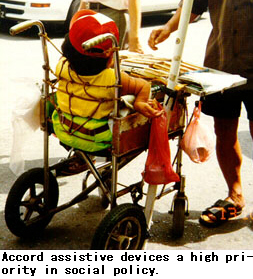
Towards the fulfilment of that goal, it is essential that the state undertake, inter alia, the following:
- Train people with disabilities on assistive devices, for informed choice and use as well as the production and distribution of devices.
- Make available various appropriate assistive devices that meet the needs of people with disabilities for economic and social participation, supported by the promotion of non-handicapping environments for, and the fostering of positive attitudes towards, people with disabilities.
- Allocate adequate funding for promoting the participation of people with disabilities (including through programmes on assistive devices), which, as a proportion of aggregate national and subnational budgets, is at least equivalent to the proportion of people with disabilities in the population.
- Require all government agencies with development activities, as well as NGOs, science and technology institutions, academic institutions and organizations of industry that receive government support, to make budgetary allocations for supporting disability work, including the development and implementation of activities concerning assistive devices which improve the lives of the poor.
- Designate a high-level government (or government-recognized) agency, with executive powers and adequate funding, to:
- (i) Guide, streamline and monitor the multidisciplinary arrangements of diverse government agencies, NGOs and institutions concerning the production and distribution of assistive devices in ways and at levels which are convenient for people with disabilities, given the lack of accessibility of most infrastructure and services;
- (ii) Undertake the necessary measures to facilitate the strengthening of disability data for developing and monitoring action plans on assistive devices at all levels, including promoting the review of all existing survey data sources which could yield relevant disability information and the training of survey enumerators to familiarize them with disability issues;
- (iii) Prepare annual reports on the status of work on assistive devices and other aspects crucial to the participation of people with disabilities in society, for dissemination to all concerned parties, including legislative bodies and people with disabilities;
- (iv) Undertake the ground work for strengthening legislative and policy provisions to make appropriate devices available to people with disabilities as an entitlement, particularly for skill enhancement, employment, income-generation and community participation purposes.
Within this overall framework, the following are the principles and objectives of a sample national policy, as well as the tasks of international organizations, Governments and NGOs, at national and subnational levels, as contained in a sample national plan on assistive devices.
B. Principles
Government policy on assistive devices may include the following principles:
- Recognize that assistive devices are only one aspect of the actions that must be taken to address the problems commonly faced by people with disabilities. Assistive devices must be considered in conjunction with accessible environments, positive changes in social attitudes, and prevention of causes of disabilities.
- Accord assistive devices a high priority in social policy as a whole, and include explicit provisions on assistive devices in legislation and policies which affect the well-being of people with disabilities and the availability of services and components for the production and distribution of assistive devices.
- Encourage the indigenous production and distribution of assistive devices, including those for people with visual impairments and hearing impairments, as their devices are mainly imported into Asian and Pacific developing countries and do not suffice to meet local needs.
- Recognize that the highest level of technology is not always the best. A simple but professional approach is usually the most helpful.
- Ensure the development of national capacity through the training of at least four different groups (with emphasis on training women and men with disabilities in all groups):
- (i) expert technologists to disseminate the latest information;
- (ii) technicians to perform specialized jobs of production, repair and maintenance;
- (iii) village artisans and mechanics to make simple devices, and repair and maintain devices in areas where technician services are not easily available;
- (iv) users, who should know enough to make an informed selection of devices and be able to maintain them.
- Emphasize community-level innovation and support collaboration among people with disabilities, their communities (including local mechanics, technicians and artisans), researchers and rehabilitation personnel.
C. Policy objectives
The policy may have the following objectives:
- Encourage distributors of assistive devices, especially NGOs, to locate their services in rural areas.
- Develop national capacity in the field of assistive devices, which includes mobile specialists who regularly transfer their experiences from workshop to workshop.
- Ensure that assistive devices distributed to people with disabilities are effective, easy to use, inexpensive to maintain, and enable their users to live more active and meaningful lives in their own communities than would otherwise be the case.
- Develop a system of decentralized production so that users can have the devices most suited to their needs, with only the least user-specific devices (e.g., hearing aids and braille writing frames) and certain components being mass-produced.
D. International-level actions
Governments and NGOs in the Asia-Pacific region could, in close collaboration with members of the United Nations system, undertake the follow- ing:
1. Share resources for training and innovation
- Organize inter-country training programmes on assistive devices to remedy the shortage, in many Asian and Pacific developing countries, of trained technical personnel and institutional infrastructure for training.
- Promote inter-country collaborative research and development (R&D) on assistive devices in order to optimize the efficient use of the resources allocated to R&D in each participating country.
- Promote, and as appropriate arrange for, assistive devices deve-loped in one country to be field-tested in others, in order to contribute to an improvement of design in the long term, and, in the short term, determine their suitability for use in other countries.
2. Exchange information on national and local experiences
- Document, for wide dissemination, employment-related examples of modifications to devices, machines and layout of a variety of workplaces.
- Use directories of assistive devices as a starting point for promoting intra-regional trade in assistive devices and their components, which may be used directly to prevent production at non-competitive costs. The information may be placed on an Internet website for easy access and include indications of whether producers of assistive devices are ready to export them.
- Share experiences (successes and failures) of national programmes related to assistive devices for the benefit of those countries considering such programmes.
3. Facilitate exchange of devices within the region
- Facilitate the import and export of assistive devices and their components among developing countries in the ESCAP region through, inter alia:
- (i) relaxation or elimination of import regulations and procedures;
- (ii) reduction or elimination of duties on assistive devices, with the aim of supporting intra-regional trade through economies of scale in the production of devices;
- (iii) raising of awareness concerning equalization of opportunities and the role of assistive devices among customs departments and agencies dealing with import and export regulations and procedures.
- Produce for publicity purposes information on customs duties and procedures relating to assistive devices, and disseminate the information through the networks of government agencies and NGOs dealing with assistive devices as part of their support for the participation of people with disabilities in development programmes.
- Discuss ways of minimizing the negative effect of intellectual property regimes on the cost of transferring technology and knowledge, which would benefit the indigenous producers of assistive devices in the ESCAP region.
- Make available those technologies to which Governments own the rights, without charging royalties when the technologies are used in other countries.
- Initiate a process of negotiation of some common, appropriate regional quality-control systems acceptable to all developing countries, to facilitate the adoption of quality control by individual developing countries that will not hinder exchange of technologies.
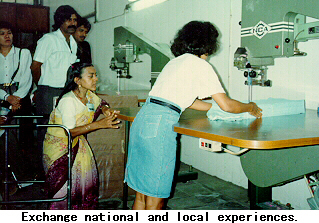
E. National-level actions
Governments at the central level may take the following actions:
1. Coordinate assistive-device services within the country
- Foster in-country cooperation and coordination on decisions affecting the availability of assistive devices among all government agencies, NGOs, industry, academic institutions and R&D institutions concerned with assistive devices. The Government agencies include those dealing with social development or welfare, health, education, employment, science and technology, rural and urban development, industry, supplies, finance, commerce and law.
- Explore and encourage the use of the following to enhance the production of assistive devices:
- (i) expertise in related fields (e.g., science, technology and university affairs);
- (ii) new materials (e.g., titanium and its alloys).
2. Provide funding support
- Fund directly, and support through other means, the development, production and distribution of assistive devices. This is essential to ensure adequate long-term supply of assistive devices, especially in a developing country.
- Cover all costs of, or subsidize, assistive devices for poor people with disabilities, and similarly subsidize the costs of transportation, board and lodging for visits to rehabilitation facilities. Government schemes should permit the provision of more than one assistive device to those people who have such a need in order to pursue training, employment, voluntary work, recreational and/or other activities for meaningful life in the community.
- Subsidize the costs of repairing and maintaining any devices obtained under government-supported programmes, and provide financial support to skilled people at the community level for providing these services.
- Encourage industries, through incentives with financial benefits, to provide assistive devices and make access improvements to reduce barriers to the employment of people with disabilities, especially in higher-level (management or technical) positions. For example, an industry could be given tax exemption on the purchase of assistive devices, or the Government could supply them to the industry when it employs people with disabilities.
- Financially encourage agencies that are or could be involved in disability issues to:
- (i) identify user needs in rural communities;
- (ii) disseminate information on assistive devices to rural communities;
- (iii) set up workshops and camps for producing assistive devices;
- (iv) mobilize artisans, technicians and mechanics to work on assistive devices through appropriate training.
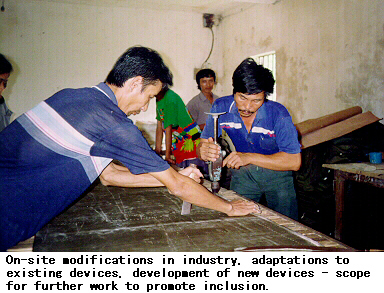
3. Adopt appropriate regulations and procedures
- Adopt quality-control standards with caution and only when necessary, to avoid discouraging innovation and low-cost production aimed at meeting the needs of the majority of people with disabilities in developing countries of the region.
- Require compliance with standards only for those devices subsidized by government programmes, in order to encourage innovation.
- Support the production of adapted motorcycles by eliminating restrictions against the modification of motorcycles and, if possible, providing a subsidy for their adaptation.
- Introduce guidelines to discourage sellers of assistive devices from raising their prices through the inclusion of the prices of technologies which are no longer patented, or are not directly related to, the devices under consideration.
- Streamline procedures, with maximum consideration to the convenience and limited resources of the poor. This may enable people with disabilities to obtain the devices they need and receive services such as assessment, fitting, training and follow-up, without bureaucratic requirements involving visits to numerous offices on many occasions.
4. Provide and/or support services for training
- Use existing training infrastructure for health-care personnel to strengthen training in the production of assistive devices, especially prostheses and orthoses.
- Review the curricula for the training of health-care personnel, in order to include training on rehabilitation and assistive devices.
- Establish a system of recognizing rehabilitation technicians in order to confer higher status on them in the societies of the Asian and Pacific developing countries.
- Develop expertise in the design and production of dies for thermoplastic components, as their use will likely increase with the increasing use of thermoplastics in assistive devices.
- Introduce rehabilitation engineering into the curriculum of engineering colleges and universities, especially those that are government-supported.
- Promote the inclusion of people with disabilities in training programmes on assistive devices, in the following respects:
- (i) as participants, to be trained in various aspects of the production and distribution of assistive devices;
- (ii) as resource persons, to advise on the substantive content of the training programme and/or to teach, particularly on user perspectives concerning design, production, assessment, fitting and the usefulness of devices for the empowerment of people with disabilities.
- Upgrade the training of older technicians to put them on par with younger ones when new training methods and techniques are introduced.
F. Subnational-level actions
Governments at local, municipal, regional, provincial or state levels may take the following actions:
1. Collect data on people with disabilities and assistive devices
- Include in surveys (e.g., those on households, poverty alleviation, employment, education and health), questions to seek data on people with disabilities and introduce measures to estimate data on diverse groups with disabilities, the extent of their representation among the poor and unemployed, and their levels of literacy, as well as on other indicators. Planning concerning the production and distribution of assistive devices and training for these functions requires such data. General data are required to monitor whether existing demand is being met.
- Support, in appropriate ways, the introduction of training for survey teams on the formulation of questions to seek information on disabilities, enumeration, data analysis and the use of data from a variety of existing sources, to enhance the quality of data which can be used for the development of a national policy plan and programme on assistive devices.
- Introduce measures for the regular identification of local sources for the production of components, to facilitate the increased local production, availability and price competitiveness of components. Producers may then obtain parts directly rather than attempting to produce them at non-competitive costs.
- Identify types of jobs in the production and distribution of assistive devices which can be efficiently carried out by people with disabilities, both in the organized and informal sectors, and make that information available to all parties in a position to support the training and employment of people with disabilities for the jobs identified.
- Interview local people with disabilities to seek information on informal innovations of devices produced locally, and support their sharing that information with people with disabilities within and outside of the country, or at subregional or regional levels.
- Compile and update (e.g., through postal questionnaire surveys via government and NGO channels) a directory of all locally available devices with names and addresses of producers and distributors. Include the market prices of the devices and their basic features in the directory. Pay special attention to the inclusion in the directory of new, small and innovative producers and distributors, and to those producing devices for women and girls with disabilities.
2. Publicize and distribute information about assistive devices
- Provide basic knowledge about assistive devices, and their liberating potential for people with disabilities, to all officials engaged in implementing rural and urban development programmes, especially those for poverty alleviation and infrastructure development.
- Develop and implement training programmes for village artisans and mechanics on strengthening their skills to repair and maintain assistive devices and innovate new designs.
- Publicize information on assistive devices through government agencies (including primary health-care centres), NGOs, civic groups (including those not working on disability matters), institutions of higher learning, R&D institutions, distance learning programmes, industry associations, users, their families and helpers, and the mass media (especially programmes directed at rural communities).
- Use fairs and other local events to create awareness about the availability of the devices. The information must be placed where people, especially in rural areas, have easy access to it. Make information on assistive devices available on an Internet website, wherever facilities exist, and encourage users of the website to offer new information through e-mail as well.
- Develop appropriate ways of explaining the design and production of assistive devices to members of local communities with limited exposure to sophisticated technology, in order to encourage them to work on assistive devices.
- Facilitate meetings of users of assistive devices in small geographical areas, to:
- (i) enable them to share problems and solutions in the use of assistive devices;
- (ii) help them encourage other people with disabilities to learn about assistive devices and overcome hesitation about using them;
- (iii) support the development of a collective voice of people with disabilities on local issues concerning assistive devices, and approach local development resources on resolving these issues.
- Publicize the results of surveys which include questions on disability data (see Section F 1. of this Chapter) and ensure their dissemination to agencies working with local communities, especially those in the places where the surveys have been conducted.
- Convene meetings of device distributors to discuss local information with them. This would facilitate the planning of distribution services.
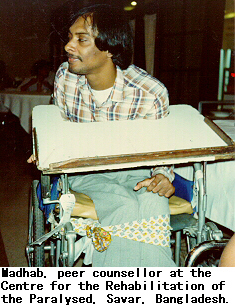
3. Provide or support services for the production,
distribution, repair and maintenance of devices
- Equip, with facilities and trained personnel to prescribe and produce assistive devices, all hospitals located in parts of the country without rehabilitation centres.
- Establish, with village community participation (e.g., contribution of land and services for building and management), integrated multipurpose workshops to address the technical needs of villages, including those related to assistive devices, where such workshops do not already exist. Government funding for the integrated multipurpose workshops could be provided for a minimum of five to seven years.
- Develop monitoring mechanisms to ensure that the production and distribution of assistive devices meet the needs of all people with disabilities, especially those in poor communities.
- Support the formation of local groups, composed of users of assistive devices and their family members. NGOs, policy makers, and professionals, including technologists, may be encouraged to support the groups through the provision of resource allocations and technical advice, as required. These groups may pursue local actions to ensure the quality and coverage of services concerning assistive devices for local-community users, with special attention to children, and women and girls with disabilities.
- Encourage those organizations and agencies which are active in rural areas but not working on disability matters to assist in the provision of basic rehabilitation services, including assistive devices, through financial and other support measures. See Section F of Chapter XI for sample measures that the organizations and agencies may take.
- Introduce and strengthen the inclusion of rehabilitation and assistive-device services in programmes for primary health care, child development, youth skills development and other aspects of community development.
Go back to the Contents
ECONOMIC AND SOCIAL COMMISSION FOR ASIA AND THE PACIFIC
Production and distribution of assistive devices for people with disabilities: Part 1
- Chapter 12 -
Printed in Thailand
November 1997 1,000
United Nations Publication
Sales No. E.98.II.F.7
Copyright c United Nations 1997
ISBN: 92-1-119775-9
ST/ESCAP/1774
